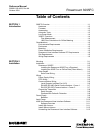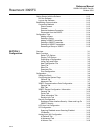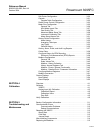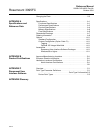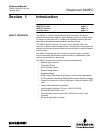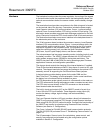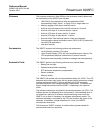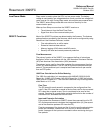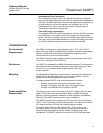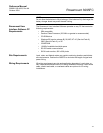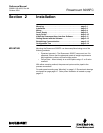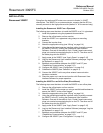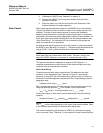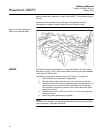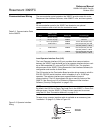
1-5
Rosemount 3095FC
Reference Manual
00809-0100-4832, Rev AA
October 2004
Instantaneous Rate Calculations
The instantaneous value of the IV is used with the previous calculation
period of the Integral Multiplier Value (IMV) to compute the instantaneous
flow rate. The IMV is defined as the value resulting from the calculation of
all other factors of the flow rate equation not included in the IV. The
instantaneous flow rate is used with the volumetric heating value to
compute the instantaneous energy rate.
Flow and Energy Accumulation
The averages of the DP and SP, temperature, and sum of the IV are used
with the flow time to compute the flow and energy over the calculation
period. The flow and energy are then accumulated and stored at the top of
every hour. At the configured contract hour, the flow and energy are stored
to the Daily Historical Log and zeroed for the start of a new day.
CONSIDERATIONS
Environmental
Requirements
The 3095FC is designed to operate between -40 to 75°C (-40 to 167°F).
When mounting, ambient temperatures may effect the operating temperature.
Operation beyond the recommended temperature range may cause
measurement error and erratic performance.
The 3095FC should not be exposed to levels of vibration that exceed 2g for
15 to 150 Hz and 1g for 150 to 2000 Hz.
Enclosures The 3095FC is packaged in a NEMA 4 windowed enclosure The enclosure is
fabricated from die-cast aluminum alloy with iridite plating and paint. There
are two ¾-in. pipe threaded holes for field conduit wiring, and
communications.
Mounting Provide adequate clearance for wiring, service, and solar panel. Mount on a
pipestand or to an orifice plate using a 3- or 5-valve manifold. The LCD
display can be rotated 90 degrees in either direction.
For solar-powered 3095FC units orient solar panels as follows:
• Northern Hemisphere: due south (not magnetic south)
• Southern Hemisphere: and due north (not magnetic north)
• Sunlight is not blocked from 9:00 AM to 4:00 PM.
Power Installation
Requirements
The primary power source is provided through DC voltage sources or solar
power. Route power away from hazardous areas, sensitive monitoring
devices, and radio equipment. Adhere to all local, company, and National
Electrical Code (NEC) requirements for power installations.
The 3095FC accepts input voltages from 8.0 volts to 28 volts at the charge
(CHG+ / CHG-) terminals on the termination board. The maximum power for
DC voltage sources is 130 mW, not including battery charging.
An external solar panel connects to the CHG+ / CHG- inputs on the
termination board. Circuitry on the battery charger board monitors and
regulates the charge based on battery voltage, charging voltage, and
temperature. The 3095FC requires a minimum 8-volt 200 mA solar panel.



